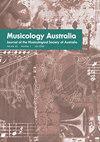Claiming the ‘Song of the Women of the Menero Tribe’
IF 0.4
0 MUSIC
引用次数: 1
Abstract
This article aims to re-evaluate Johann Lhotsky’s published sheet music ‘A Song of the Women of the Menero Tribe near the Australian Alps’ to claim it as a distinctively Ngarigu document that speaks to Ngarigu people today. Following a method suggested by Graeme Skinner, we recover additional information, strip out the ‘improvements’ of the arrangers and create a new Ngarigu-oriented reading with what we hope will be ‘real value for song revitalisation’ by providing ‘usable details’ of text, melody and rhythm. We suggest that the evidence tends to substantiate Skinner’s suggestion that Lhotsky’s original publication was more ‘ethnographically honest’ than Isaac Nathan’s revision. We present new conclusions as to who originally performed the Song, and when and where the performance witnessed by Lhotsky took place. We show that Lhotsky’s untranslated text is clearly in an Aboriginal language and provides important clues to its significance to Ngarigu Country. We contend that various musical features of Lhotsky’s publication, while departing from the norms of settler colonial parlour music, bear witness instead to Ngarigu performance practice of the time.宣称“Menero部落妇女之歌”
本文旨在重新评价Johann Lhotsky出版的乐谱《澳大利亚阿尔卑斯山附近Menero部落妇女之歌》,称其为一部独特的Ngarigu文献,与今天的Ngarigui人对话。按照格雷姆·斯金纳提出的方法,我们恢复了额外的信息,去掉了编曲人的“改进”,并通过提供文本、旋律和节奏的“可用细节”,创造了一种新的以Ngarigu为导向的阅读,我们希望这将是“歌曲复兴的真正价值”。我们认为,证据倾向于证实斯金纳的说法,即霍茨基的原始出版物比艾萨克·内森的修订更“民族志诚实”。我们给出了新的结论,关于谁最初表演了这首歌,以及霍茨基见证的表演何时何地发生。我们发现,霍茨基的未翻译文本显然是土著语言,并为其对恩加里古国家的意义提供了重要线索。我们认为,Lhotsky出版物的各种音乐特征,在背离定居者殖民地客厅音乐规范的同时,反而见证了当时的Ngarigu表演实践。
本文章由计算机程序翻译,如有差异,请以英文原文为准。
求助全文
约1分钟内获得全文
求助全文

 求助内容:
求助内容: 应助结果提醒方式:
应助结果提醒方式:


